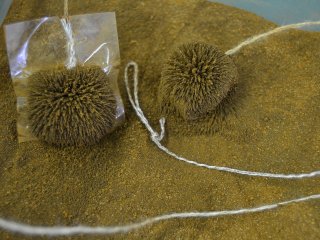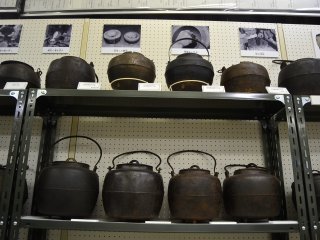When you see this building for the first time, you may not think that it is a museum. Referred to as Kuji Historic Folk Museum (Kuji-shi Rekishi Minzoku Shiryokan), this building has many impressive collections that can give a clue as to what life was like in Kuji in the past. There are four main exhibition halls. The first exhibition hall displays many collections of iron and steel that were produced in Kuji. Maybe not many people are aware of the fact that Kuji was formerly a major producer of iron and steel. Going to the next exhibition hall, you will come across exhibits relating to famous people who came from Kuji with various kinds of professions. From teachers, poets, to politicians. Go on to the third exhibition hall, and you will see ancient pottery that dates from the pre-historic era. Last but not least, you will find many household items donated by local people from Kuji that have a strong connection with the area.
- 1 min read
Kuji Historical Folk Museum
In depth look at Kuji's distinctive history - for free!

By Sarashanti
Community writer

Famous iconic clothes from Kuji worn by diving women, ama-san, who catch sea urchins and other shellfish using a net and metal hook (soegaki). (Photo: Mifthanzi Ariana Sarashanti)

Local sand taken from the Kuji area that contains iron. This is clearly demonstrated when the sand is touched directly with a magnet. (Photo: Mifthanzi Ariana Sarashanti)

Diorama that depicts iron manufacturing in Kuji in the Edo period (1605-1868). (Photo: Mifthanzi Ariana Sarashanti)

Categorized iron waste that came from the traditional manufacturing process (tatarabuki kiln) that can be seen in the diorama. (Photo: Mifthanzi Ariana Sarashanti)

Old iron teapots that were forged locally. (Photo: Mifthanzi Ariana Sarashanti)

Scrolls (emaki) that record the traditional manufacturing process of iron through text and pictures. (Photo: Mifthanzi Ariana Sarashanti)

Old coins. (Photo: Mifthanzi Ariana Sarashanti)

Reconstructed old pottery from the pre-historic era. (Photo: Mifthanzi Ariana Sarashanti)

Non-electric traditional freezer. (Photo: Mifthanzi Ariana Sarashanti)

A hand-driven machine traditionally used to remove the chaff from rice. (Photo: Mifthanzi Ariana Sarashanti)

Traditional spinning machine. (Photo: Mifthanzi Ariana Sarashanti)

Spears that were used for fishing. (Photo: Mifthanzi Ariana Sarashanti)
Explore nearby
Leave a comment
0 comments in total
Book your trip
Find a nearby hotel
Explore some of the best nearby hotels and deals for the perfect place to stay in Japan.
Top Articles
-
![Aichi Awaits: Seven Authentic Experiences Beyond Nagoya Aichi Awaits: Seven Authentic Experiences Beyond Nagoya]() 1
1Aichi Awaits: Seven Authentic Experiences Beyond Nagoya
Aichi - Sponsored -
![I’m Donut?: Japan’s Viral Donut Sensation I’m Donut?: Japan’s Viral Donut Sensation]() 2
2I’m Donut?: Japan’s Viral Donut Sensation
Culture -
![Mt. Fuji Hike 2025: New Safety Rules & Registration Guide Mt. Fuji Hike 2025: New Safety Rules & Registration Guide]() 3
3Mt. Fuji Hike 2025: New Safety Rules & Registration Guide
Shizuoka - Sponsored -
![An Enriching Getaway in Ome City An Enriching Getaway in Ome City]() 4
4An Enriching Getaway in Ome City
Tokyo - Sponsored -
![Hokkaido Full Immersion Tour Hokkaido Full Immersion Tour]() 5
5Hokkaido Full Immersion Tour
Hokkaido -
![Kyushu Craftsmanship and Traditions Heritage Tour Kyushu Craftsmanship and Traditions Heritage Tour]() 6
6Kyushu Craftsmanship and Traditions Heritage Tour
Article -
![Tokyo Auto Salon 2026 Japan Car Tour: Cars, Culture & The Open Road Tokyo Auto Salon 2026 Japan Car Tour: Cars, Culture & The Open Road]() 7
7Tokyo Auto Salon 2026 Japan Car Tour: Cars, Culture & The Open Road
Chiba -
![70 Nations, One Amazing Meal 70 Nations, One Amazing Meal]() 8
870 Nations, One Amazing Meal
Osaka - Sponsored -
![LUUP: The New Age of Bike Rentals in Japan? LUUP: The New Age of Bike Rentals in Japan?]() 9
9LUUP: The New Age of Bike Rentals in Japan?
Transportation -
![Osaka Noh Festa Osaka Noh Festa]() 10
10Osaka Noh Festa
Osaka - Sponsored
-
![Guide to Bringing Medicines Into Japan Guide to Bringing Medicines Into Japan]() 1
1Guide to Bringing Medicines Into Japan
Planning -
![The Ultimate Guide to Thrifting in Tokyo The Ultimate Guide to Thrifting in Tokyo]() 2
2The Ultimate Guide to Thrifting in Tokyo
Shopping -
![Your Name: Real-Life Locations in Tokyo Your Name: Real-Life Locations in Tokyo]() 3
3Your Name: Real-Life Locations in Tokyo
Tokyo -
![Japanese Urban Legends Japanese Urban Legends]() 4
4Japanese Urban Legends
Culture -
![Gion Matsuri Gion Matsuri]() 5
5Gion Matsuri
Kyoto -
![Iwatayama Monkey Park Iwatayama Monkey Park]() 6
6Iwatayama Monkey Park
Kyoto -
![Daikoku Car Meet Daikoku Car Meet]() 7
7Daikoku Car Meet
Kanagawa -
![Tokyo Pride Tokyo Pride]() 8
8Tokyo Pride
Tokyo -
![Black Eggs of Owakudani, Hakone Black Eggs of Owakudani, Hakone]() 9
9Black Eggs of Owakudani, Hakone
Kanagawa -
![Ghibli 3D Sculpture Exhibition Ghibli 3D Sculpture Exhibition]() 10
10Ghibli 3D Sculpture Exhibition
Tokyo



































